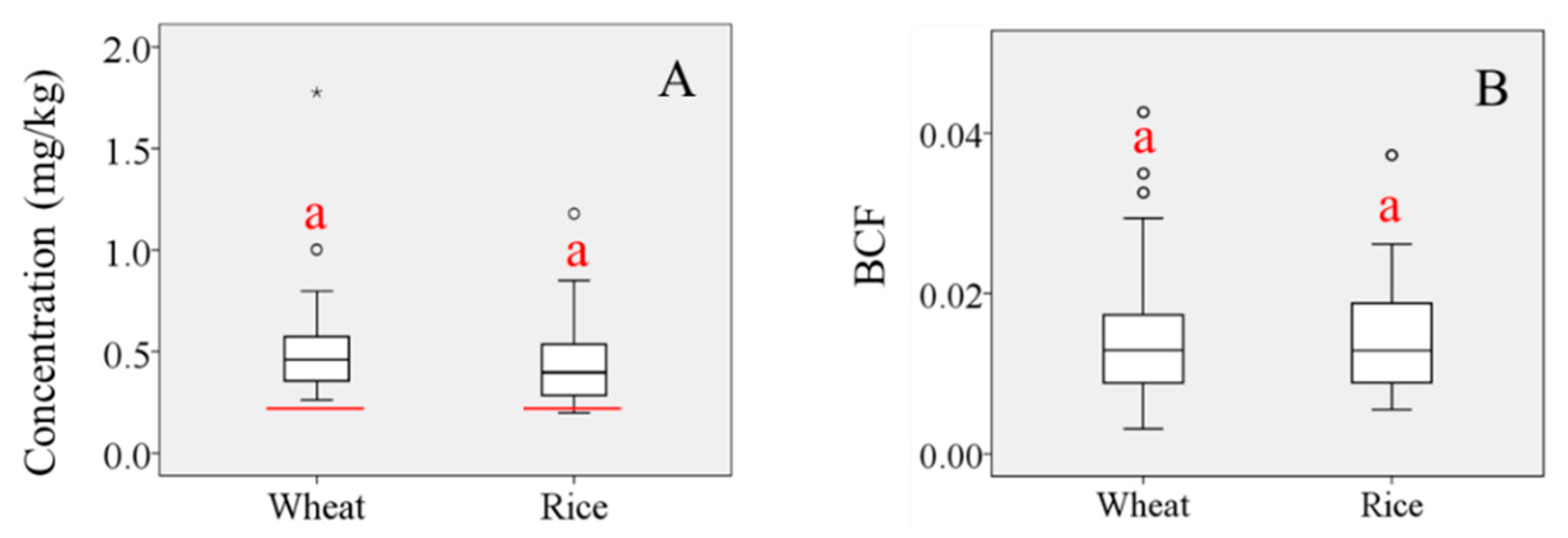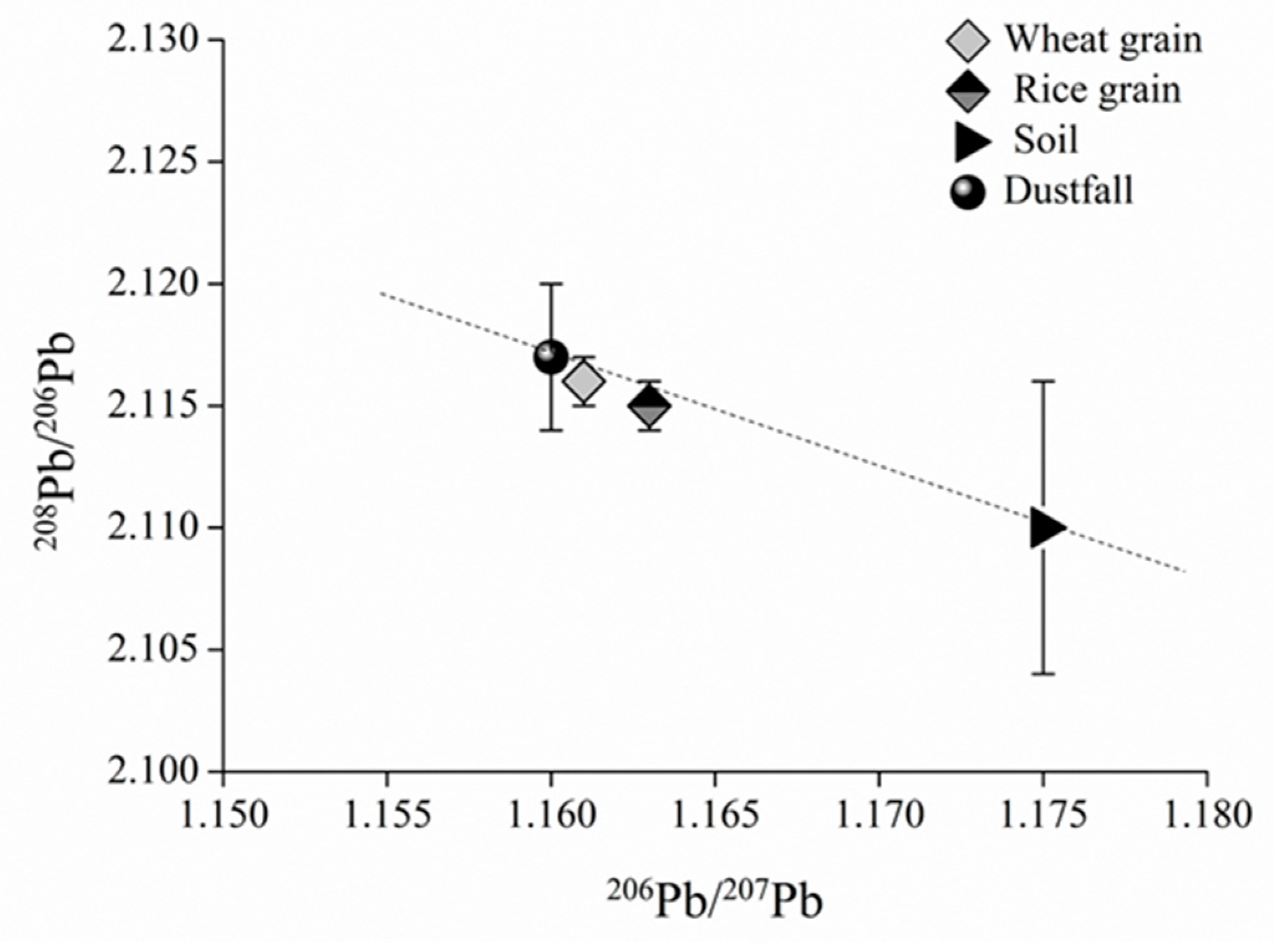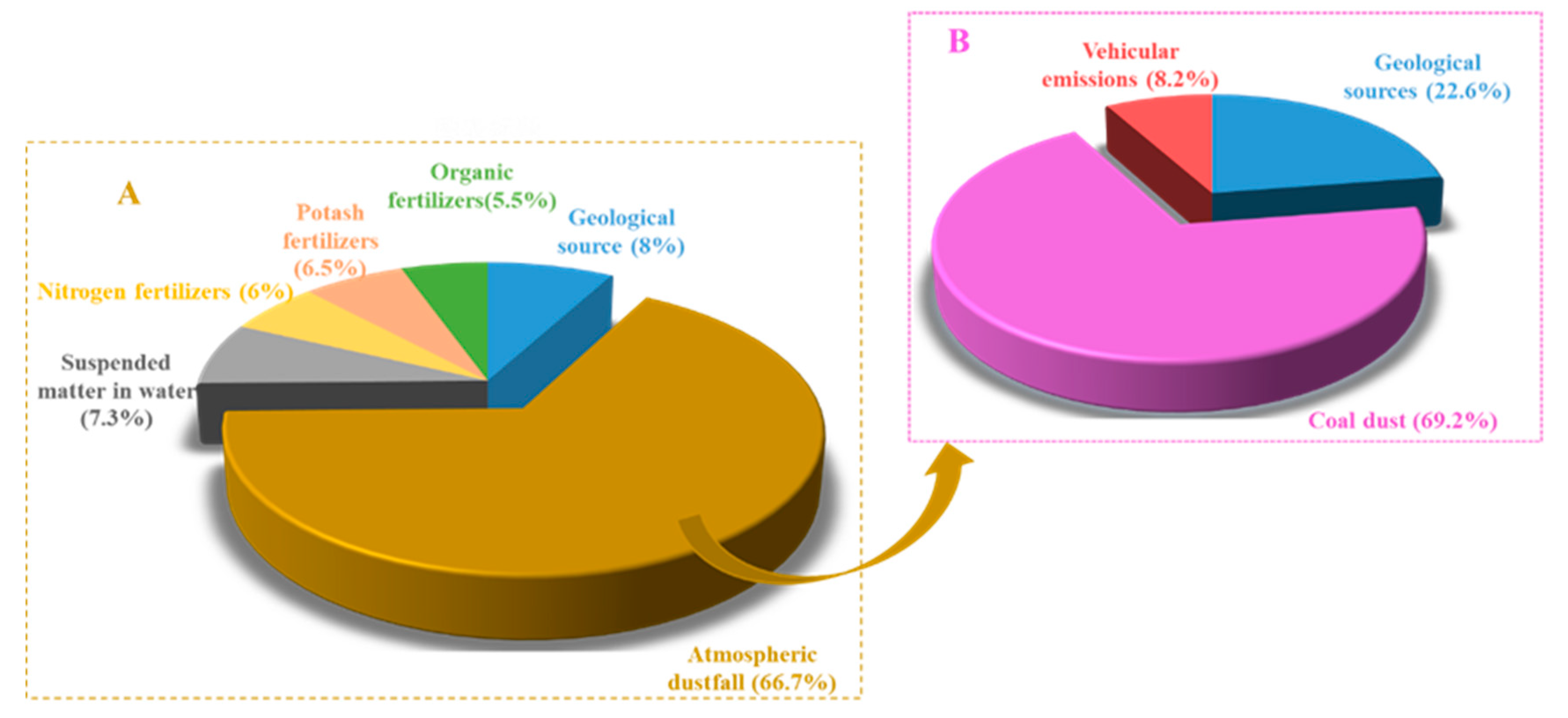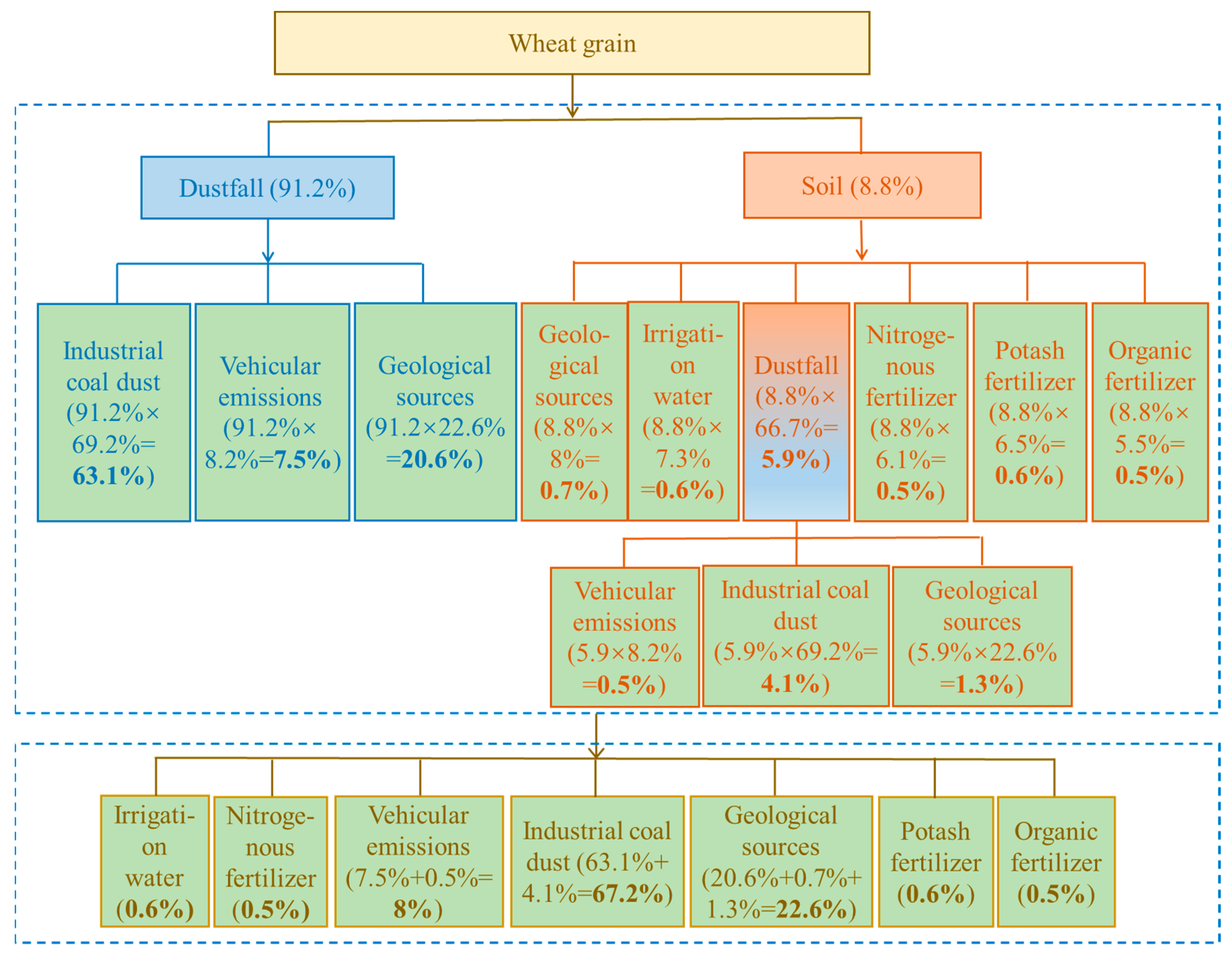Pb Content, Risk Level and Primary-Source Apportionment in Wheat and Rice Grains in the Lihe River Watershed, Taihu Region, Eastern China
Abstract
1. Introduction
2. Methods
2.1. Field Sampling
2.1.1. Grains
2.1.2. Soils
2.1.3. Atmospheric Dustfall
2.1.4. Primary Source Samples of Grain
2.2. Sample Testing
2.3. Data Analysis
2.3.1. Ecological Risk
2.3.2. Health Risk
2.3.3. Source Apportionment Model
- (1)
- Two-end-member mixing model
- (2)
- IsoSource model
3. Results and Discussion
3.1. Pb Levels and Risk in Soil and Dustfall
3.2. Pb Levels in Grains
3.3. Pb Risk Assessment of Grain
3.4. Source Apportionment for Grain
3.4.1. Direct-Source Apportionment for Grain
3.4.2. Primary-Source Apportionment for Grain
Source Apportionment for Soil and Dustfall
Primary-Source Apportionment Progress for Grains
3.4.3. Summary about Three-Stage Quantitative Analysis Results
4. Conclusions
Supplementary Materials
Author Contributions
Funding
Institutional Review Board Statement
Informed Consent Statement
Acknowledgments
Conflicts of Interest
References
- Li, H.; Chen, K.; Juhasz, A.L.; Huang, L.; Ma, L.Q. Childhood Lead Exposure in an Industrial Town in China: Coupling Stable Isotope Ratios with Bioaccessible Lead. Environ. Sci. Technol. 2015, 49, 5080–5087. [Google Scholar] [CrossRef]
- Wu, H.; Liu, Q.; Ma, J.; Liu, L.; Qu, Y.; Gong, Y.; Yang, S.; Luo, T. Heavy Metal (loids) in typical Chinese tobacco-growing soils: Concentrations, influence factors and potential health risks. Chemosphere 2020, 245, 125591.1–125591.11. [Google Scholar] [CrossRef] [PubMed]
- Akber, M.A.; Rahman, M.A.; Islam, M.A. Potential ecological risk of metal pollution in lead smelter-contaminated agricultural soils in Khulna, Bangladesh. Environ. Monit. Assess. 2019, 191, 1–12. [Google Scholar] [CrossRef] [PubMed]
- Xing, W.; Yang, H.; Ippolito, J.A.; Zhang, Y.; Scheckel, K.G.; Li, L. Lead source and bioaccessibility in windowsill dusts within a Pb smelting-affected area. Environ. Pollut. 2020, 266 Pt 2, 115110. [Google Scholar] [CrossRef]
- Walraven, N.; van Os, B.; Klaver, G.; Middelburg, J.; Davies, G. The lead (Pb) isotope signature, behaviour and fate of traffic-related lead pollution in roadside soils in The Netherlands. Sci. Total Environ. 2014, 472, 888–900. [Google Scholar] [CrossRef] [PubMed]
- Wen, H.; Zhang, Y.; Cloquet, C.; Zhu, C.; Fan, H.; Luo, C. Tracing sources of pollution in soils from the Jinding Pb–Zn mining district in China using cadmium and lead isotopes. Appl. Geochem. 2015, 52, 147–154. [Google Scholar] [CrossRef]
- Jin, Y.; O’Connor, D.; Ok, Y.S.; Tsang, D.C.; Liu, A.; Hou, D. Assessment of sources of heavy metals in soil and dust at children’s playgrounds in Beijing using GIS and multivariate statistical analysis. Environ. Int. 2019, 124, 320–328. [Google Scholar] [CrossRef]
- Mao, C.; Song, Y.; Chen, L.; Ji, J.; Li, J.; Yuan, X.; Yang, Z.; Ayoko, G.; Frost, R.L.; Theiss, F. Human health risks of heavy metals in paddy rice based on transfer characteristics of heavy metals from soil to rice. Catena 2019, 175, 339–348. [Google Scholar] [CrossRef]
- Yang, J.; Wang, J.; Qiao, P.; Zheng, Y.; Yang, J.; Chen, T.; Lei, M.; Wan, X.; Zhou, X. Identifying factors that influence soil heavy metals by using categorical regression analysis: A case study in Beijing, China. Front. Environ. Sci. Eng. 2020, 14, 1–14. [Google Scholar]
- Feng, J.; Wang, Y.; Zhao, J.; Zhu, L.; Bian, X.; Zhang, W. Source attributions of heavy metals in rice plant along highway in Eastern China. J. Environ. Sci. 2011, 23, 1158–1164. [Google Scholar] [CrossRef]
- Jeong, H.; Choi, J.Y.; Lee, J.; Ra, K. Investigations of Pb and Cu Isotopes to Trace Contamination Sources from the Artificial Shihwa Lake in Korea. J. Coast. Res. 2020, 95 (Suppl. 1), 1122. [Google Scholar] [CrossRef]
- Turner, A. Lead pollution of coastal sediments by ceramic waste. Mar. Pollut. Bull. 2019, 138, 171–176. [Google Scholar] [CrossRef] [PubMed]
- Ahmed, M.K.; Shaheen, N.; Islam, M.S.; Habibullah-Al-Mamun, M.; Islam, S.; Banu, C.P. Trace elements in two staple cereals (rice and wheat) and associated health risk implications in Bangladesh. Environ. Monit. Assess. 2015, 187, 326. [Google Scholar] [CrossRef] [PubMed]
- Chen, H.M.; Chunrong, Z.; Cong, T.U.; Yongguan, Z. Heavy metal pollution in soil in china: Status and countermeasures. AMBIO 1999, 28, 130–134. [Google Scholar]
- Li, B.; Wang, M.; Liu, G. Status and problems of heavy metal pollution and detection technology in farmland soil. In Seminar on Prevention and Control Technology and Risk Assessment of Heavy Metal Pollution; Chinese Society For Environmental Sciences: Beijing, China, 2011. [Google Scholar]
- Zhang, S. Analysis and Evaluation of Heavy Metal Pollution in Farmland Soil and Wheat Grain around Lantian Smelter. Master’s Thesis, Shanxi Normal University, Taiyuan, China, 2009. [Google Scholar]
- Ji, K.; Kim, J.; Lee, M.; Park, S.; Kwon, H.-J.; Cheong, H.-K.; Jang, J.-Y.; Kim, D.-S.; Yu, S.; Kim, Y.-W.; et al. Assessment of exposure to heavy metals and health risks among residents near abandoned metal mines in Goseong, Korea. Environ. Pollut. 2013, 178, 322–328. [Google Scholar] [CrossRef] [PubMed]
- Hu, X.; Sun, Y.; Ding, Z.; Zhang, Y.; Wu, J.; Lian, H.; Wang, T. Lead contamination and transfer in urban environmental compartments analyzed by lead levels and isotopic compositions. Environ. Pollut. 2014, 187, 42–48. [Google Scholar] [CrossRef]
- Lee, P.K.; Yu, S. Lead isotopes combined with a sequential extraction procedure for source apportionment in the dry deposition of Asian dust and non-Asian dust-ScienceDirect. Environ. Pollut. 2016, 210, 65–75. [Google Scholar] [CrossRef] [PubMed]
- Yu, Y.; Li, Y.; Li, B.; Shen, Z.; Stenstrom, M.K. Metal enrichment and lead isotope analysis for source apportionment in the urban dust and rural surface soil. Environ. Pollut. 2016, 216, 764–772. [Google Scholar] [CrossRef]
- Yip, Y.C.; Lam, C.W.; Tong, W.F. Applications of lead isotope ratio measurements. Trends Anal. Chem. 2008, 27, 460–480. [Google Scholar] [CrossRef]
- Gao, B.; Lu, J.; Hao, H.; Yin, S.; Yu, X.; Wang, Q.; Sun, K. Heavy Metals Pollution and Pb Isotopic Signatures in Surface Sediments Collected from Bohai Bay, North China. Sci. World J. 2014, 2014, 158796. [Google Scholar] [CrossRef][Green Version]
- Shang, Y. Heavy Metal Pollution Character in Soil-Plant System and Study on Lead Isotopic Tracing—A Case Study of Typical Cities in Chengdu Economic Areas. Ph.D. Thesis, Chengdu University of Technology, Chengdu, China, 2007. [Google Scholar]
- Hu, X.; Cao, M. Contamination with heavy metals and Pb isotope ratios of vegetables and soils. Environ. Pollut. Control 2009, 31, 102–104. [Google Scholar]
- Zhao, D. Source Identification/Apportionment and Transfer Route of Typical Heavy Metal in an Industrial Area. Ph.D. Thesis, Chinese Academy of Agricultural Sciences, Beijing, China, 2012. [Google Scholar]
- Xia, X.; Yang, Z.; Yu, T.; Hou, Q.; Mutelo, A.M. Detecting changes of soil environmental parameters by statistics and GIS: A case from the lower Changjiang plain, China. J. Geochem. Explor. 2017, 181, 116–128. [Google Scholar] [CrossRef]
- Jiao, W.; Lu, S.; Li, G.; Jing, X.; Yu, H.; Cai, M. Heavy metal pollution and ecological risk assessment of main rivers in Taihu river basin. J. Appl. Environ. Biol. 2010, 16, 577–580. [Google Scholar]
- Li, H. Non-point pollutant concentrations for different land uses in lihe river watershed of Taihu region. China Environ. Sci. 2006, 26, 243–247. [Google Scholar]
- Chen, L.; Zhou, S.; Shi, Y.; Wang, C.; Li, B.; Li, Y.; Wu, S. Heavy metals in food crops, soil, and water in the Lihe River Watershed of the Taihu Region and their potential health risks when ingested. Sci. Total Environ. 2017, 615, 141–149. [Google Scholar] [CrossRef]
- Lin, C.; Wu, Z.; Ma, R.; Su, Z. Detection of sensitive soil properties related to non-point phosphorus pollution by integrated models of SEDD and PLOAD. Ecol. Indic. 2016, 60, 483–494. [Google Scholar] [CrossRef]
- Chen, L.; Gao, J.; Zhu, Q.; Wang, Y.; Yang, Y. Accumulation and Output of Heavy Metals in Spartina Alterniflora in a Salt Marsh. Pedosphere 2018, 28, 884–894. [Google Scholar] [CrossRef]
- Chen, L.; Wang, G.; Wu, S.; Xia, Z.; Cui, Z.; Wang, C.; Zhou, S. Heavy Metals in Agricultural Soils of the Lihe River Watershed, East China: Spatial Distribution, Ecological Risk, and Pollution Source. Int. J. Environ. Res. Public Health 2019, 16, 2094. [Google Scholar] [CrossRef] [PubMed]
- Cai, L.M.; Xu, Z.-C.; Qi, J.-Y.; Feng, Z.-Z.; Xiang, T.-S. Assessment of exposure to heavy metals and health risks among residents near Tonglushan mine in Hubei, China. Chemosphere 2015, 127, 127–135. [Google Scholar] [CrossRef] [PubMed]
- Zhou, S. Economic Development and Spatiotemporal Variation of Heavy Metals in Agricultural Land; China Earth Press: Beijing, China, 2011. [Google Scholar]
- Huang, M.; Zhou, S.; Sun, B.; Zhao, Q. Heavy metals in wheat grain: Assessment of potential health risk for inhabitants in Kunshan, China. Sci. Total Environ. 2008, 405, 54–61. [Google Scholar] [CrossRef] [PubMed]
- Li, T.; Huang, Y.; Wu, C.; He, Z.; Japenga, J.; Deng, M.; Yang, X. An integrated approach to assess heavy metal source apportionment in peri-urban agricultural soils. J. Hazard. Mater. 2015, 299, 520–529. [Google Scholar]
- Li, S.; Zhang, Q. Response of dissolved trace metals to land use/land cover and their source apportionment using a receptor model in a subtropic river, China. J. Hazard. Mater. 2011, 190, 205–213. [Google Scholar] [CrossRef]
- Fabrice, M.; Lancelot, J.; Croudace, I.W.; Cundy, A.B.; Lewis, J.T. Pb Isotopic Composition of Airborne Particulate Material from France and the Southern United Kingdom: Implications for Pb Pollution Sources in Urban Areas. Environ. Sci. Technol. 1997, 31, 2277–2286. [Google Scholar]
- Gregg, P.J.W. Source partitioning using stable isotopes: Coping with too many sources. Oecologia 2003, 136, 261–269. [Google Scholar]
- Tao, W.; Cheng, L.; Nie, Q.; Huang, Q.; Wang, J. Linear correlation between soluble lead in soil and lead content in surface plants. Geol. Anhui 2015, 25, 197–200. [Google Scholar]
- Yang, W.; Chen, W.; Yang, Y.; Liu, C.; Ma, L. Bioavailability and ecological risk assessment of heavy metals in soils around a mining area in Xinjiang, China. J. Environ. Eng. 2019, 13, 166–175. [Google Scholar]
- Cai, K.; Luan, W.L.; Li, S.M.; Li, C.; Feng, X.; Li, Q.Q. Analysis of the Source of Heavy Metal Elements in Atmosphere over Shijiazhuang City. Earth Environ. 2012, 40, 37–42. [Google Scholar]
- Shi, G.; Chen, Z.; Teng, J.; Bi, C.; Zhou, D.; Sun, C.; Li, Y.; Xu, S. Fluxes, variability and sources of cadmium, lead, arsenic and mercury in dry atmospheric depositions in urban, suburban and rural areas. Environ. Res. 2012, 113, 28–32. [Google Scholar] [CrossRef] [PubMed]
- Yang, J.; Chen, T.; Lei, M.; Zhou, X.; Huang, Q.; Ma, C.; Gu, R.; Guo, G. New isotopic evidence of lead contamination in wheat grain from atmospheric fallout. Environ. Sci. Pollut. Res. Int. 2015, 22, 14710–14716. [Google Scholar] [CrossRef]
- Dalenberg, J.W.; Driel, W.V. Contribution of atmospheric deposition to heavy-metal concentrations in field crops. Adv. Exp. Soc. Psychol. 1990, 28, 1–51. [Google Scholar] [CrossRef]
- Zhao, F.J.; Adams, M.L.; Dumont, C.; McGrath, S.P.; Chaudri, A.M.; Nicholson, F.A.; Chambers, B.J.; Sinclair, A.H. Factors affecting the concentrations of lead in British wheat and barley grain. Environ. Pollut. 2004, 131, 461–468. [Google Scholar] [CrossRef] [PubMed]
- Ryan, J.A.; Chaney, R.L. Heavy Metals and Toxic Organic Pollutants in MSW-Composts: Research Results on Phytoavailability, Bioavailability, Fate, etc. Environmentalences 1994, 451–506. [Google Scholar]
- Chamberlain, A.C. Fallout of lead and uptake by crops. Atmos. Environ. 1983, 17, 693–706. [Google Scholar] [CrossRef]
- Pan, Y.M. The Lower Changjiang (Yangzi/Yangtze River) metallogenic belt, east central China: Intrusion- and wall rock-hosted Cu–Fe–Au, Mo, Zn, Pb, Ag deposits. Ore Geol. Rev. 1999, 15, 177–242. [Google Scholar] [CrossRef]
- Mukai, H.; Furuta, N.; Fujii, T.; Ambe, Y.; Sakamoto, K.; Hashimoto, Y. Characterization of sources of lead in the urban air of Asia using ratios of stable lead isotopes. Environ. Sci. Technol. 1993, 27, 1347–1356. [Google Scholar] [CrossRef]
- Mukai, H.; Tanaka, A.; Fujii, T.; Zeng, Y.; Hong, Y.; Tang, J.; Guo, S.; Xue, H.; Sun, Z.; Zhou, J.; et al. Regional characteristics of sulfur and lead isotope ratios in the atmosphere at several Chinese urban sites. Environ. Sci. Technol. 2001, 35, 1064. [Google Scholar] [CrossRef] [PubMed]
- Zhu, B.; Chen, Y.; Peng, J. Lead isotope geochemistry of the urban environment in the Pearl River Delta. Appl. Geochem. 2001, 16, 409–417. [Google Scholar]





| Parameter | Samples | Minimum Value | Maximum Value | Mean | SD | |
|---|---|---|---|---|---|---|
| Concentration | Soil (n = 32) | Pb-s | 21.26 | 141.72 | 39.78 | 20.61 |
| Pb-sa | 12.51 | 91.84 | 26.84 | 13.61 | ||
| Dustfall (n = 10) | 73.82 | 328.97 | 223.86 | 76.33 | ||
| Background values of Jiangsu | - | - | 26.2 | - | ||
| Chinese standard for agriculture soil | - | - | 300 | - | ||
| Pi | Soil (n = 32) | 0.81 | 5.41 | 1.52 | 0.79 | |
| Dustfall (n = 10) | 2.82 | 12.56 | 8.54 | 2.91 |
| Grain Type | Pb-s | Pb-sa | Pb-d | pH | CEC | EC | OM | Mean Particle Size |
|---|---|---|---|---|---|---|---|---|
| Wheat | 0.045 | 0.063 | 0.426 * | –0.135 | –0.014 | 0.039 | –0.346 | 0.027 |
| Rice | 0.036 | 0.214 | 0.360 * | 0.407 * | –0.023 | 0.126 | 0.187 | –0.076 |
| HQ | Child | Adult |
|---|---|---|
| Wheat grain | 2.67 × 10−1 | 2.43 × 10−1 |
| Rice grain | 5.12 × 10−1 | 4.70 × 10−1 |
Publisher’s Note: MDPI stays neutral with regard to jurisdictional claims in published maps and institutional affiliations. |
© 2021 by the authors. Licensee MDPI, Basel, Switzerland. This article is an open access article distributed under the terms and conditions of the Creative Commons Attribution (CC BY) license (https://creativecommons.org/licenses/by/4.0/).
Share and Cite
Chen, L.; Zhou, S.; Yang, Q.; Li, Q.; Xing, D.; Xiao, Y.; Tang, C. Pb Content, Risk Level and Primary-Source Apportionment in Wheat and Rice Grains in the Lihe River Watershed, Taihu Region, Eastern China. Int. J. Environ. Res. Public Health 2021, 18, 6256. https://doi.org/10.3390/ijerph18126256
Chen L, Zhou S, Yang Q, Li Q, Xing D, Xiao Y, Tang C. Pb Content, Risk Level and Primary-Source Apportionment in Wheat and Rice Grains in the Lihe River Watershed, Taihu Region, Eastern China. International Journal of Environmental Research and Public Health. 2021; 18(12):6256. https://doi.org/10.3390/ijerph18126256
Chicago/Turabian StyleChen, Lian, Shenglu Zhou, Qiong Yang, Qingrong Li, Dongxu Xing, Yang Xiao, and Cuiming Tang. 2021. "Pb Content, Risk Level and Primary-Source Apportionment in Wheat and Rice Grains in the Lihe River Watershed, Taihu Region, Eastern China" International Journal of Environmental Research and Public Health 18, no. 12: 6256. https://doi.org/10.3390/ijerph18126256
APA StyleChen, L., Zhou, S., Yang, Q., Li, Q., Xing, D., Xiao, Y., & Tang, C. (2021). Pb Content, Risk Level and Primary-Source Apportionment in Wheat and Rice Grains in the Lihe River Watershed, Taihu Region, Eastern China. International Journal of Environmental Research and Public Health, 18(12), 6256. https://doi.org/10.3390/ijerph18126256





